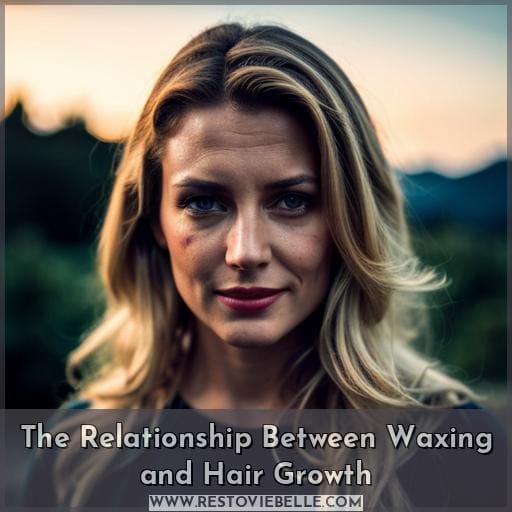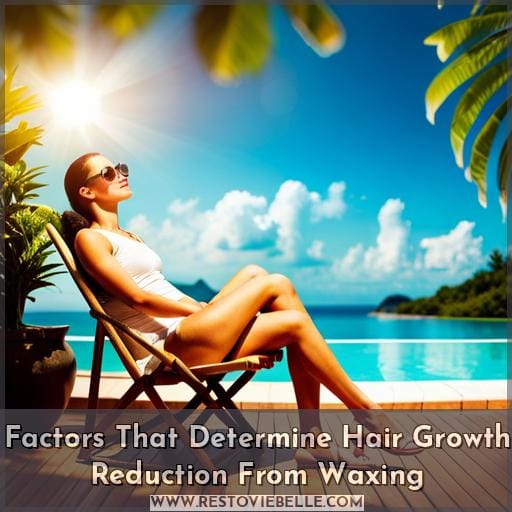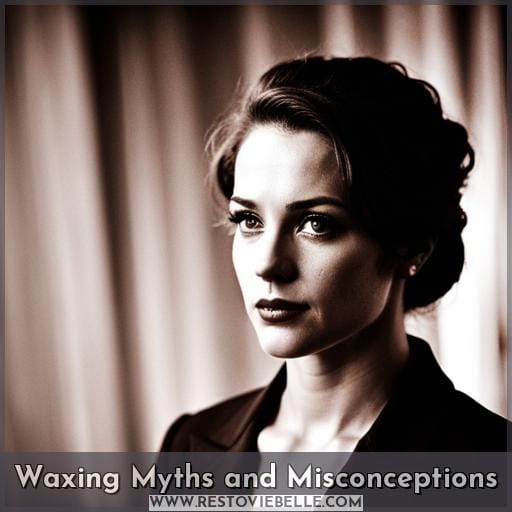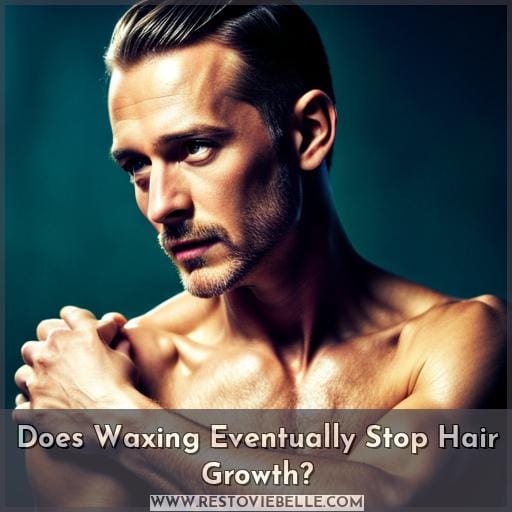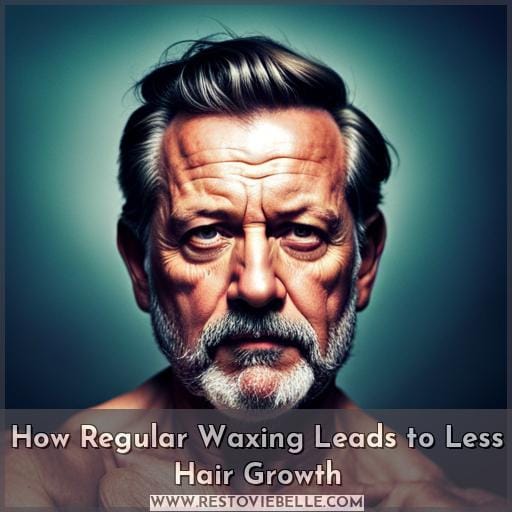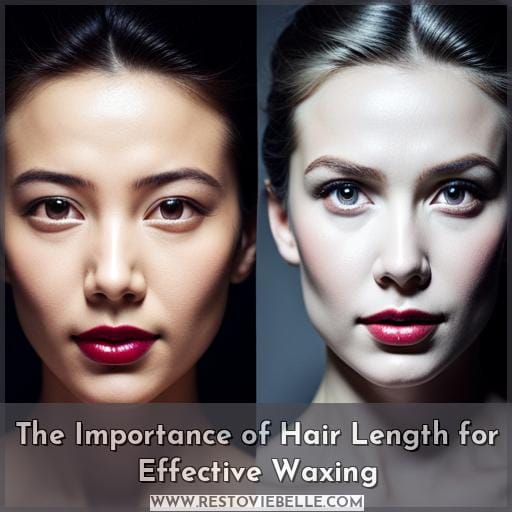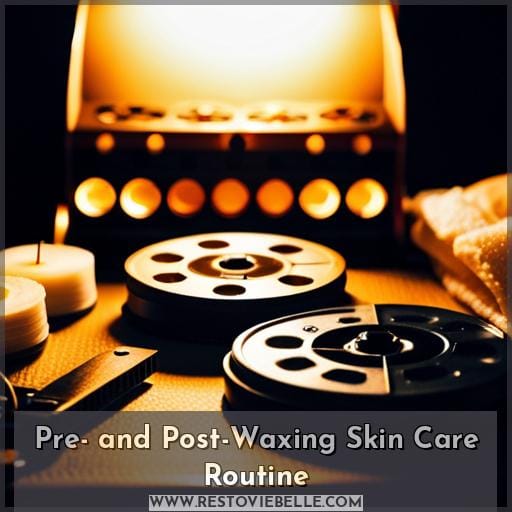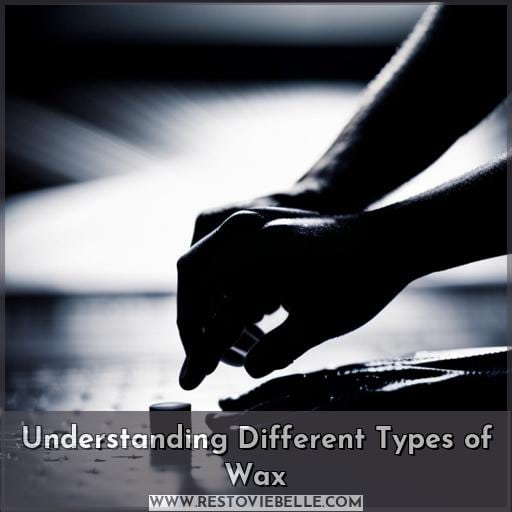This site is supported by our readers. We may earn a commission, at no cost to you, if you purchase through links.
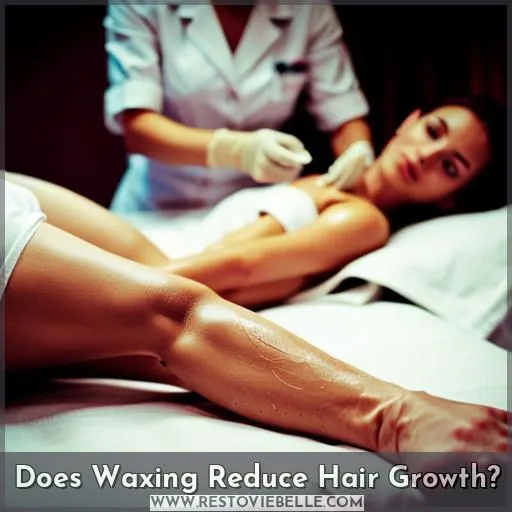 Are you tired of battling the fuzzies on a regular basis? If so, you may be wondering if waxing your hair can help reduce its growth. Many people have heard that this is possible, but there are mixed opinions about whether it’s true or not.
Are you tired of battling the fuzzies on a regular basis? If so, you may be wondering if waxing your hair can help reduce its growth. Many people have heard that this is possible, but there are mixed opinions about whether it’s true or not.
In order to get to the bottom of it and determine whether waxing really does reduce hair growth, let’s explore what we know about how waxing affects our body’s natural process for growing hairs. We’ll look at factors like age limits and skin sensitivity as well as myths surrounding different types of waxes in order to gain an understanding of how regular wax treatments might affect your body over time.
Finally, we will discuss proper pre- and post-wax care routines so that you can enjoy smooth results while taking good care of your skin!
Table Of Contents
- Key Takeaways
- How Does Waxing Affect Hair Growth?
- The Relationship Between Waxing and Hair Growth
- Factors That Determine Hair Growth Reduction From Waxing
- Waxing Myths and Misconceptions
- Does Waxing Eventually Stop Hair Growth?
- How Regular Waxing Leads to Less Hair Growth
- The Importance of Hair Length for Effective Waxing
- Pre- and Post-Waxing Skin Care Routine
- Understanding Different Types of Wax
- Finding a Professional Waxing Service
- Conclusion
Key Takeaways
- Waxing can reduce hair growth over time.
- Waxing damages follicles, leading to thinner and softer regrowth.
- Regular waxing leads to finer and slower hair regrowth.
- Factors like hair texture and genetics influence waxing effectiveness.
How Does Waxing Affect Hair Growth?
By regularly waxing, you can enjoy smoother skin and longer-lasting hair removal benefits with less regrowth over time. Hair regrowth after waxing depends on factors such as the texture of your hair, genetics, and frequency of treatments.
Generally speaking, when it comes to length before a wax session, aim for 1/4 to 1/2 inch (0.
Waxing damages follicles, resulting in thinner and softer regrowth while reducing overall growth significantly if done consistently. Depending on an individual’s genetic makeup, this could be anywhere from 3 weeks up to 6 weeks between sessions in order to maximize the benefits.
Additionally, exfoliation plays an important role pre and post-treatment to keep ingrown hairs at bay. However, no matter how often one gets into a routine of regular appointments, caution should always be taken due to excessive damage caused by incorrect technique or product used.
The Relationship Between Waxing and Hair Growth
Regularly waxing can make a significant impact on the rate of your hair growth. Waxing removes the hair from its roots, thus slowing down regrowth and leading to a decrease in overall hair density over time.
When done regularly (3-6 weeks apart), it can extend periods between appointments while still being an affordable method for long-term removal or permanent results with continued use over time. The damage inflicted by waxing weakens follicles, which alters their texture resulting in finer hairs that are softer when they eventually do grow back.
It’s important, however, not to go overboard as too much waxing could lead to skin irritation and sensitivity. So always ensure you follow proper guidelines, such as exfoliating before/after sessions, plus moisturizing daily if possible.
Lastly, don’t forget about researching techniques/products beforehand, as well as reading reviews when choosing what type of formula suits best for both yourself and the desired outcome.
Factors That Determine Hair Growth Reduction From Waxing
The effectiveness of waxing in reducing hair growth depends on a variety of factors, such as texture, genetics, and more. Hair texture determines how easily the wax can grip onto the strand during removal.
Coarser or curly hairs are more difficult to remove due to their thickness and shape; therefore, they may not be ideal candidates for waxing benefits.
Genetics also play an important role in determining regrowth rate. People with naturally thinner strands tend to experience slower hair growth after being regularly waxed than those who have thicker strands do.
To achieve long-term results from waxing sessions, it is important to follow these steps:
- Trim or shave before you go to ensure that your hairs are at least 1/8 inch long.
- Schedule regular appointments every three weeks or so, depending on how quickly your hair grows back.
- Use a gentle scrub when exfoliating prior and post-session to prevent ingrowns.
- Moisturize often throughout the week and wear sunscreen if going out directly after treatment.
Lastly, make sure you find a professional experienced esthetician when getting any kind of facial (or body) area treated.
Waxing Myths and Misconceptions
You may have heard that excessive waxing can lead to skin sensitivity, contribute to the loss of skin elasticity, and cause ingrown hairs. Additionally, it’s often said that waxing thins the skin or changes hair thickness or growth rate.
However, many of these beliefs are myths; there is no age limit for waxing, and wrinkles don’t occur after a session either.
Excessive Waxing and Skin Sensitivity
Be aware that excessive waxing can lead to skin sensitivity and dark spots. Post-waxing care is essential; exfoliate and moisturize regularly. Avoid too frequent waxes for best results – shorter hair growth, fewer ingrown hairs, and prevention of wrinkles.
Skincare after waxing helps reduce hair growth, but not drastically or permanently.
Waxing and Skin Elasticity
Contrary to popular belief, waxing does not reduce skin elasticity. So why risk compromising your natural resilience? The effect on collagen is minimized with elastic wax, which retains more moisture for supple skin.
Wax safely and enjoy the benefits of waxing without aging prematurely! Hair removal can be done effectively while protecting vital collagen production, decreasing wrinkles caused by the loss of elasticity.
With proper pre-care and post-care, benefit from smoother, hairless skin without sacrificing youthful tone or texture.
Waxing and Ingrown Hairs
Exfoliating before and after waxing is critical for preventing or treating ingrown hairs. Waxing, as opposed to shaving, has advantages, including better skin health and longer-lasting effects. Establishing a regular schedule with an experienced esthetician will help you get the most out of your waxes.
Additionally, using at-home solutions like Uni K Wax Ingrown Hair Serum can provide quicker results.
Waxing and Skin Thinning
No matter what beauty trends come and go, it’s safe to say that waxing with elastic wax is here to stay – no need for skin thinning due to its natural ingredients! Waxing frequency impacts pain and sensitivity; proper preparation helps maintain elasticity.
Waxing and Hair Thickness
Regular waxing can result in thinner, softer hair over time. It’s important to maintain a consistent waxing schedule for the best results and follow aftercare advice, such as moisturizing and using SPF post-waxing, to avoid dark spots.
The proper length of hair is crucial, with a minimum recommended growth of 1/8 inch. Waxing should be done by a trained professional as DIY kits are not suitable for sensitive skin and may cause damage.
Waxing and Age Limit
You might be surprised to learn that there’s no age limit on waxing, though guardians must accompany anyone under 18 – so don’t let time get the best of you! Waxing can provide longevity, reduce skin sensitivity, and offer health benefits regardless of your age.
Pain tolerance levels may vary, but with proper preparation, it doesn’t have to be an issue.
Waxing and Wrinkles
Wrinkles are naturally caused by a decrease in collagen as we age, not waxing. However, too much waxing can exacerbate sensitive skin, so it is important to hydrate and exfoliate regularly. Using sunscreen is crucial for post-wax protection in order to avoid redness and irritation.
By waxing correctly, you can maintain the desired results without compromising the health of your skin.
Does Waxing Eventually Stop Hair Growth?
Consistent waxing can help you get smoother skin and potentially reduce hair growth over time. Regular appointments are the key to achieving long-term results as this allows for a more consistent removal of hairs from the root.
Waxing effectiveness is also dependent on factors like hair texture, genetics, and general health of your follicles; therefore it’s important to be aware of these variables when establishing a waxing routine.
In order to control hair growth, understand that frequent waxes may not always produce immediate results but regular maintenance will lead to longer lasting benefits in terms of reducing overall regrowth patterns and amount.
The frequency between treatments will vary depending on individual needs; however aiming for every three weeks or so should yield satisfactory outcomes with regards to maintaining thinner strands while avoiding ingrown hairs due to excessive length at each appointment time frame.
It is worth noting that despite what many myths suggest about waxing causing thinning or sagging skin – this simply isn’t true! Skin elasticity remains intact while allowing smoothness without any potential damage resulting from DIY attempts using heating elements which can cause burns instead!
Ultimately, consistency is crucial when it comes down managing the desired outcome related with successful reduction in unwanted body/facial hair via professional methods such as those provided through Uni K Wax Centers where safety & customer satisfaction remain top priorities throughout all stages involved within their process designed by Founder & CEO Noemi Grupenmager herself!
How Regular Waxing Leads to Less Hair Growth
By regularly tending to your body, you nurture it like a garden and reap the rewards of less hair growth. Waxing is an effective way to reduce hair growth in the long run. Consistent waxing leads to thinner and softer regrowth over time.
Regular appointments extend the amount of time between sessions. Hair follicles are damaged, reducing overall growth. Benefits increase with each successive session as results become more pronounced.
Skin care pre-wax, such as exfoliation or avoiding retinol products, can prevent irritation. Waxing effectiveness depends on various factors, including genetics, texture, and length of hair for optimal gripping power.
However, when done properly by a trained professional, it can provide excellent results.
Despite misconceptions that excessive waxing causes skin thinning or wrinkles – which is false – regular waxing offers numerous benefits in both appearance and convenience.
The Importance of Hair Length for Effective Waxing
For successful waxing results, it’s important to ensure your hair reaches the ideal length of 1/4 to 1/2 inch. Shorter hair won’t grip onto wax properly, while longer strands can be painful and difficult to remove in one go – leading to further discomfort.
Not only that, but trimming or shaving before an appointment will help when it comes time for removal as well as preventing ingrown hairs from forming after treatment. DIY kits may seem like a convenient option at first glance; however, they’re not suitable for sensitive skin and could lead to unwanted skin removal if used incorrectly.
It’s best left up to professional technicians who are trained in proper techniques and have access to top-quality products formulated specifically for waxing services.
Pre- and Post-Waxing Skin Care Routine
Proper pre- and post-waxing skincare is essential for achieving the best results. Moisturizing your skin before waxing helps to protect it, while exfoliating regularly afterward prevents ingrown hairs.
Choosing the right ingredients in your skincare products can also help reduce hair growth over time.
Moisturizing and Exfoliating
To keep your skin looking its best, moisturize regularly and exfoliate prior to waxing.
Moisturizing benefits include softening of the skin, improved hydration levels, reduced inflammation, and irritation.
Exfoliation techniques can help remove dead cells from the surface of your skin while also removing excess oil that could lead to clogged pores or ingrown hairs during waxing sessions.
Regularly applying a moisturizer before or after waxing helps prevent excessive dryness caused by regular removal of body hair as well as keeping the treated area nourished for maximum comfort post-treatment.
Proper pre-wax care is essential in preventing potential ingrown hairs and ensuring optimal results with each session – making it an integral part of any successful at-home or professional aftercare routine!
- Moisturizing Benefits
- Exfoliation Techniques
- Skin Hydration
- Prevent Ingrown Hairs
- Wax Aftercare
Choosing the Right Ingredients
When selecting your waxing formula, research and read reviews to ensure you’re choosing the right ingredients for your skin type. Understand which ingredients can cause skin sensitivity or irritation, as well as those that are safer options.
Natural ingredients like pine tree resin and beeswax are gentle on sensitive skin types, while other formulas contain synthetic components that may not be compatible with all skins.
Check labels of different formulations for compatibility and safety before each appointment so you know exactly what’s going onto your body during treatment.
Understanding Different Types of Wax
If you are considering waxing your skin, it is important to understand the differences between types of wax. Elastic wax is a popular choice for those with sensitive skin due to its all-natural ingredients and low-temperature application.
On the other hand, hard wax can be more effective on thick or coarse hair but has limited flexibility as it tends to crack easily when applied too thinly or pulled off too quickly.
Elastic Wax for Sensitive Skin
Considering your skin sensitivity, elastic wax is an ideal choice that provides lasting smoothness without harsh irritants. Benefits of using elastic wax include less pain and redness than other types of waxing due to its low temperature application.
It’s also gentle on the skin and can help reduce ingrown hairs if used properly in combination with exfoliation before and after your appointments.
Waxing for beginners should consider this type of product as it allows them to transition into professional waxing services more easily with minimal discomfort or irritation. Additionally, since it doesn’t adhere too strongly to the hair follicles like hard-based formulas do, you won’t experience any pulling or tugging during the removal process.
This makes it a great alternative for those who want smoother results than shaving can provide while avoiding potential razor burn from traditional methods of hair removal.
Finally, regular use will not only keep your skin looking softer but also help prevent further damage caused by frequent shaving or tweezing.
Hard Wax and Its Limitations
While hard wax can help remove hair, it also has its limitations and may break or crack during application, making it less efficient and potentially causing skin burns.
Hard wax benefits include the ability to target smaller areas for fast removal of thicker hairs. However, since this type of wax is applied at higher temperatures than elastic waxes, the pain associated with hard-waxing may be greater.
Waxing vs shaving provides longer-lasting results, but due to potential skin damage from DIY attempts at home using a kit that’s not suitable for sensitive skin, professionals are always recommended instead.
When done properly by an experienced technician following all safety protocols such as exfoliation before/afterwards, there should be no worries about experiencing any adverse effects when opting for professional hard-waxing services over traditional methods like shaving or depilatory creams!
Finding a Professional Waxing Service
Finding a waxing professional you trust can be the key to achieving long-term hair removal results. When choosing professionals, it’s important that they are experienced estheticians with quality wax products.
Visit salons in person before making your selection to get an idea of their atmosphere and customer service level. Make sure pricing options are discussed before beginning any treatments so there aren’t any surprises after the fact.
Professional waxers should use gloves, practice excellent hygiene habits, have experience removing all types of body hair, and provide customers with pre-and post-care instructions specific to each individual’s skin type or sensitivity needs.
To ensure consistent results as well as safety protocols being followed at all times, ask questions such as how often do they change out tools between clients? Are single-use applicators being used? Is the salon licensed by its local health department?
Doing this research beforehand will help prevent potential problems down the road while also helping build trust between you and your chosen professional for years to come!
Conclusion
Research shows that regular waxing can reduce hair growth over time. On average, waxing can extend the time between appointments to 3-6 weeks. In addition, waxers report that consistent waxing can result in finer and slower hair regrowth, reducing the need for frequent sessions.
However, hair growth reduction from waxing varies based on factors such as hair texture, genetics, and more. It’s important to consult with a professional waxer to determine the best type of wax for your skin and needs.
Additionally, pre- and post-waxing skin care is essential for achieving the best results. With proper care and maintenance, waxing can be an effective and affordable method for long-term hair removal.
